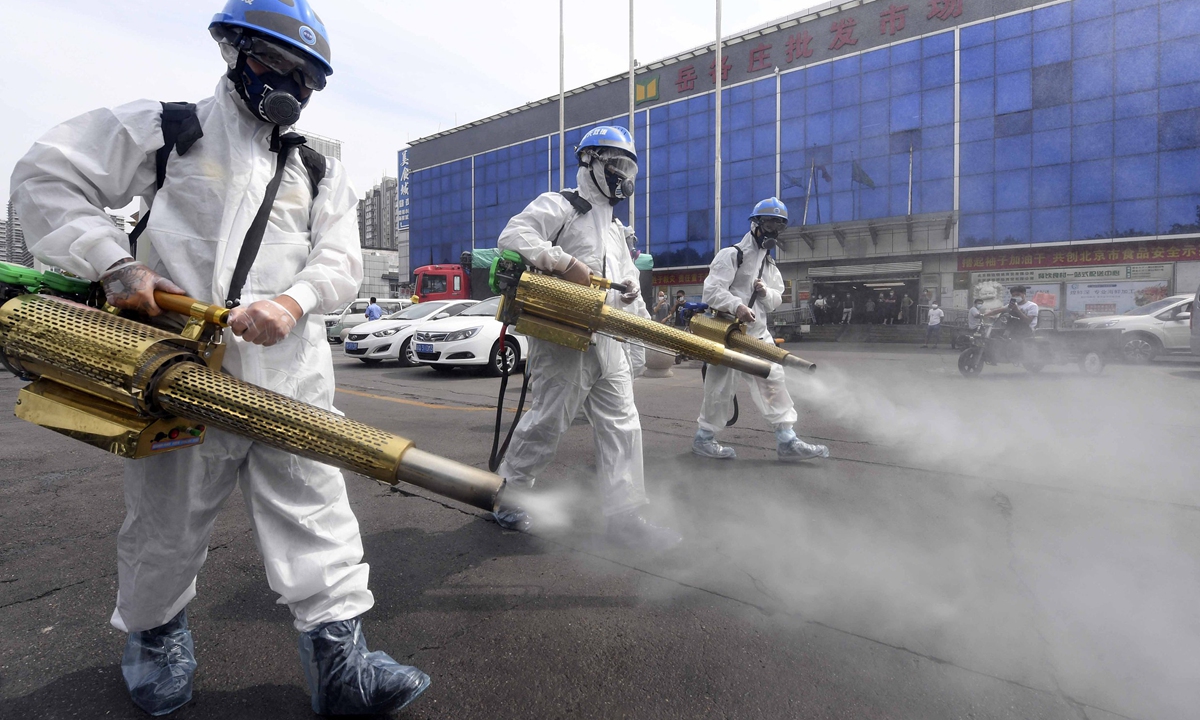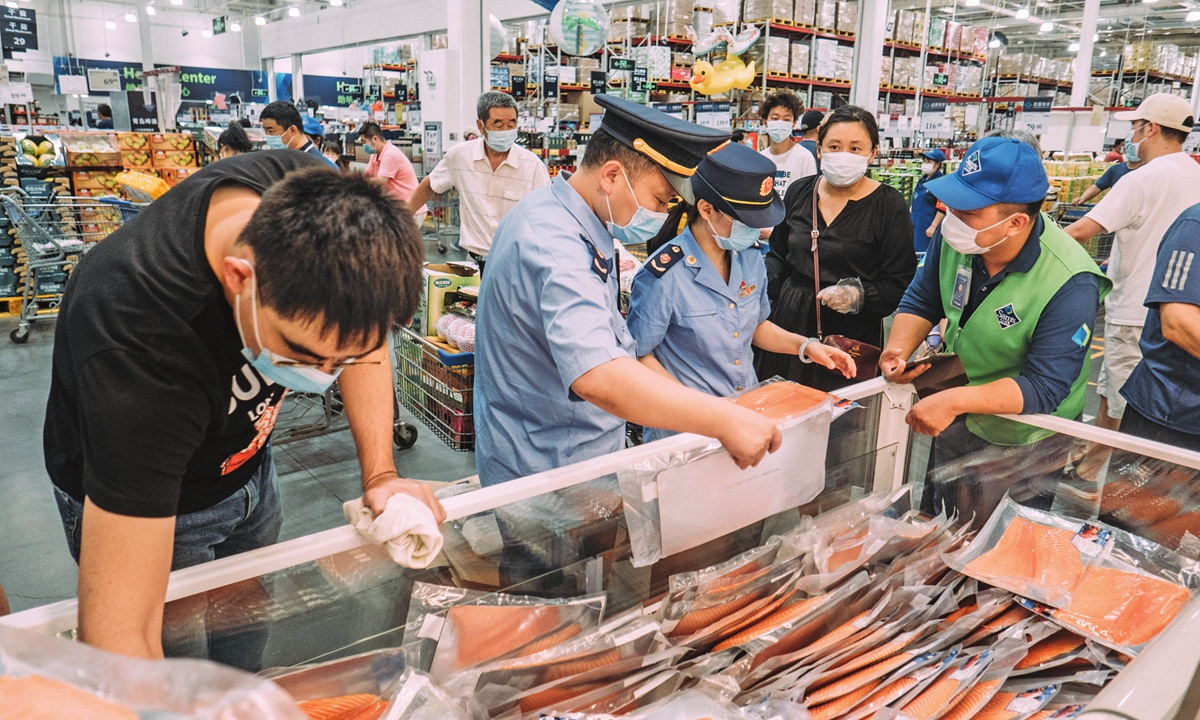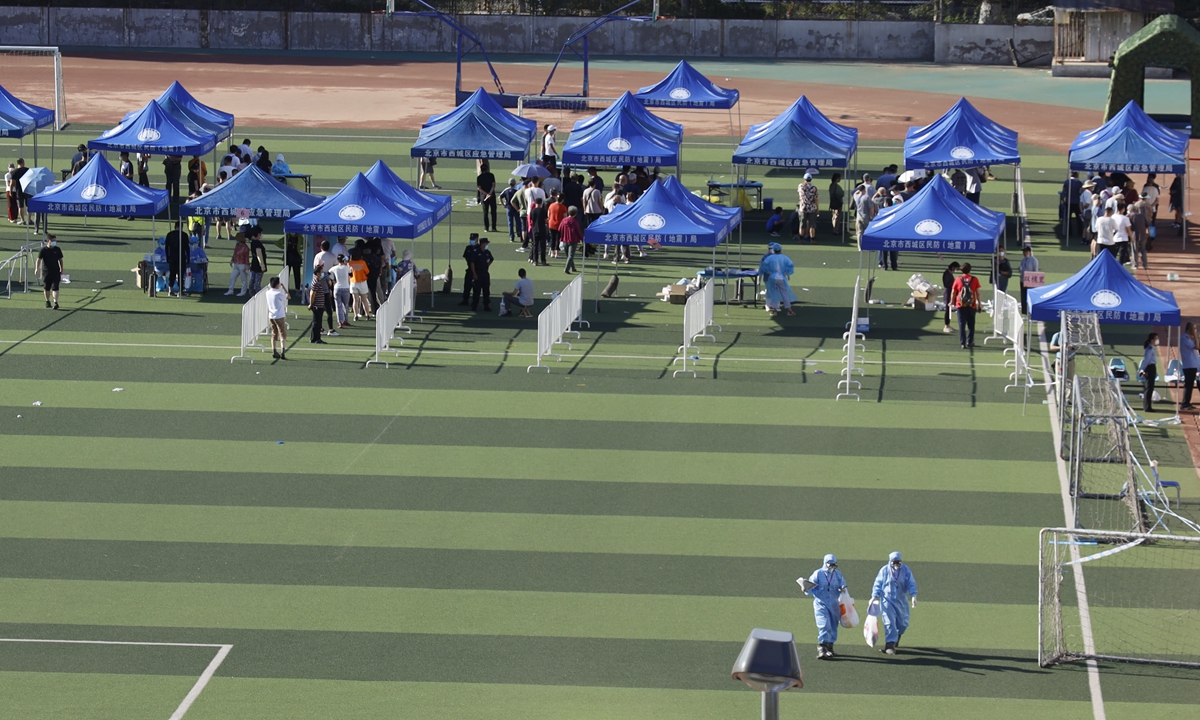Beijing raises its emergency response to Level II
By Cao Siqi, Zhang Hui and Liu Caiyu Source:Global Times Published: 2020/6/17 0:43:40
Capital city won’t be 2nd Wuhan; lockdown unlikely: expert

Volunteers from the Beijing Blue Sky Rescue Team spray disinfectant in Yuegezhuang wholesale market in Fengtai district, Beijing. The market is about 12 kilometers from the Xinfadi market, which is linked to the recent COVID-19 outbreak in the capital city. Photo: people.cn
Since the latest outbreak of COVID-19 was first uncovered in Beijing's largest wholesale food market on Thursday, Beijing reported a total of 106 confirmed cases as of Tuesday. In just five days, the capital city has been beefing up its prevention measures to curb the spread of the virus and decided to raise the emergency response from Level III to Level II on Tuesday night.
Under Level II, Beijing reinstated closed managements on communities, required people to have their temperatures taken, register with the entrance guards, and check health codes before entering the closed communities. Communities, sub-districts, streets in high/medium-risk areas would ban outsiders and cars from entering; and communities of high risk sub-districts would have closed-off management, allowing no one to leave.
Chen Bei, Beijing municipal government's deputy secretary general, announced the decision at a press conference late Tuesday night, noting the capital's situation is still grim.
Before the announcement, Beijing had locked down 29 residential communities, put four large districts into "wartime mode," disinfected 276 food markets, shut down 11 underground and semi-underground markets, screened over 200,000 people within 72 hours.
That makes it the most serious outbreak in China since February, dragging local citizens about to embrace normal life back to caution mode which they underwent four months ago. It demonstrates to ordinary residents what "normalized epidemic prevention and control" means, as experts have been saying for months, and raised the questions such as, "Will the current prevention and control situation in Beijing be upgraded again? Is a second wave of the respiratory disease coming? And will Beijing be locked down as a second Wuhan?"
Upgraded measures
In a rare move since Sunday, Beijing has been holding press conferences about the COVID-19 situation twice a day. On Tuesday's morning conference, health authorities reported another 27 confirmed cases in Beijing, bringing the total to 106.
Chen Yankai, a deputy director of the Beijing market supervision bureau, said Beijing has disinfected 276 farm produce markets and closed 11 such underground and semi-underground markets as of 6 am Tuesday, and a total of 33,173 catering services providers have also been disinfected. Beijing is expected to finish city-wide sanitation of markets and restaurants by Wednesday.
Under the COVID-19 emergency Level II, public places such as libraries, museums, art galleries and parks will implement time-limited reservations with visitor traffic no more than 30 percent.
Trans-province group travel will be halted as well. Chen Bei the senior Beijing government official also announced that Beijing Capital International Airport and Beijing Daxing International Airport have suspended inter-provincial flight services.
People from medium- and high-risk areas and personnel related to Xinfadi wholesale market are prohibited from leaving Beijing, Chen said.
On-campus classes for all primary, middle, high school and university students will be suspended from Wednesday to curb the spread of the virus as soon as possible, she noted.
Flights to and from Beijing were largely canceled shortly after Beijing raised the emergency response to Level II, under which Beijing residents who want to leave the city are required to show a nucleic acid negative permit within 7 days.
Second Wuhan?
Having witnessed the upgraded prevention and control measures, many people are concerned a possible second wave of the disease. Some Beijing residents reached by the Global Times on Tuesday said they decided to take nucleic tests to see whether they have been infected, while some said they became paranoid and felt they had contracted the virus after experiencing symptoms like diarrhea and a sore throat.
Wu Zunyou, China's top epidemiologist, believes that as the new outbreak began around the end of May, the next three days from Tuesday will be critical and decisive for the capital city to curb the epidemic.
Wang Guangfa, a respiratory expert at Peking University First Hospital in Beijing, said it is still too early to judge the scale of this round of outbreak when the source of infections remains unknown.

Food and Drug Administration employees check salmon in a Sam's Club store in Beijing on Saturday. Photo: Li Hao/GT
So far, the new cases have been linked to the Xinfadi market and have not spread widely. Beijing immediately tracked and controlled the outbreak after the initial cases were found, which played a role in preventing the spread of the epidemic, Wang told the Global Times on Tuesday.
He said the situation is different from Wuhan because Beijing has screened a large number of people in order to find potential patients. "It is abnormal to find nothing as it may prove that the city's prevention measures are not strong enough."
With the number of confirmed cases rising, Beijing immediately took prevention and control measures. Up to now, all communities in Beijing have adopted a Level-III emergency response, Level-II prevention and control measures, and Level-I working status. At the same time, Beijing has screened nearly 200,000 people who had visited the Xinfadi market since May 30, with all required to take nucleic acid tests and self-quarantine at home for further observation. On Sunday alone, Beijing tested 76,499 people and found 59 positive cases.
Despite the similarities between the outbreaks in Wuhan and Beijing, the prevention and control ability and the cognition of novel coronavirus have been greatly improved, Wang said. "Compared to the initial stage of the outbreak in Wuhan, we have a very clear understanding of the virus, and people's awareness of prevention and control has made great progress. The experience accumulated in the early days of prevention and control also provides an effective reference for prevention and control measures taken at this stage."
"Beijing will never become the second Wuhan," Wang stressed.
However, Wang warned that "if the number of new confirmed cases daily rises and the virus spreads to communities to a certain level, Beijing may consider imposing stronger anti-epidemic measures, and lock down the city."
Zeng Guang,the chief epidemiologist of the Chinese Center for Disease Control and Prevention, told the Global Times on Tuesday he believes the Chinese capital will manage the epidemic, and will not be put under a Wuhan-style lockdown despite rumors circulating among Beijing residents for days.
Zeng said one of the main reasons for the Wuhan lockdown was the Spring Festival travel rush, also known as the largest human migration in the world, when about 3 billion Chinese travel around the country for family reunions each year.

People come to Fengtai Sports Center for COVID-19 nucleic acid tests on Sunday. Photo: Li Hao/GT
China imposed a lockdown on Wuhan on January 23, two days ahead of the 2020 Spring Festival.Although Beijing has a population of 20 million, their movements could be controlled at this time of the year, Zeng said.
Rumors circulating online recently said highways leading into the capital were closed. Officials from Beijing's traffic control department denied the rumor, saying they had not received any notice about closing roads into Beijing. Major Chinese express delivery companies also denied rumors that the delivery of packages to Beijing had been suspended.
Tracing the source
Gao Fu, the director of the Chinese Center for Disease Control and Prevention, said Monday that the center has completed the sequencing and analysis of the entire genome of the virus from the relevant case samples. Preliminary conclusions have been reported, and tracing of the virus is ongoing.
Previously, Yang Peng, an expert at the Beijing Center for Diseases Prevention and Control, pointed to Europe as the source of the strain of the coronavirus which caused the new outbreak.
Wang said the sequencing and analysis of the genome could help determine whether the virus in the latest spike is the same novel coronavirus; and if so, whether the virus has mutated.
It will also help determine the source of the virus. "This is a very important clue. By studying the sequence of the virus, it is theoretically possible to determine which country the contaminated seafood came from," he said, noting that tracing the origin may even be helpful to the earlier outbreak in Wuhan.
Posted in: SOCIETY,FOCUS